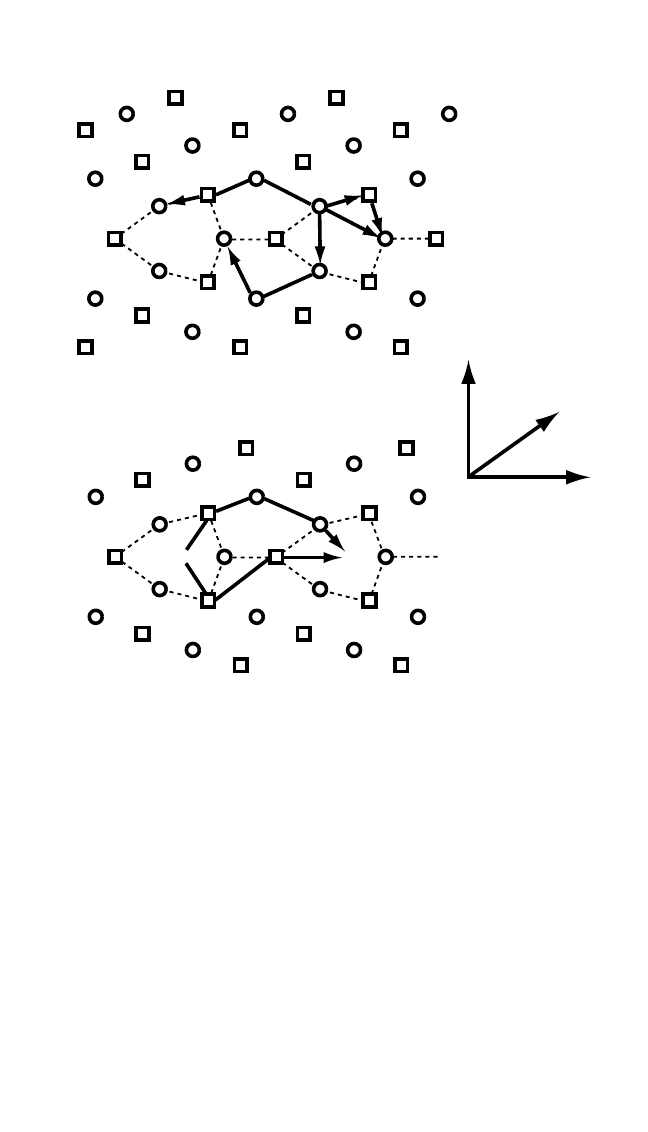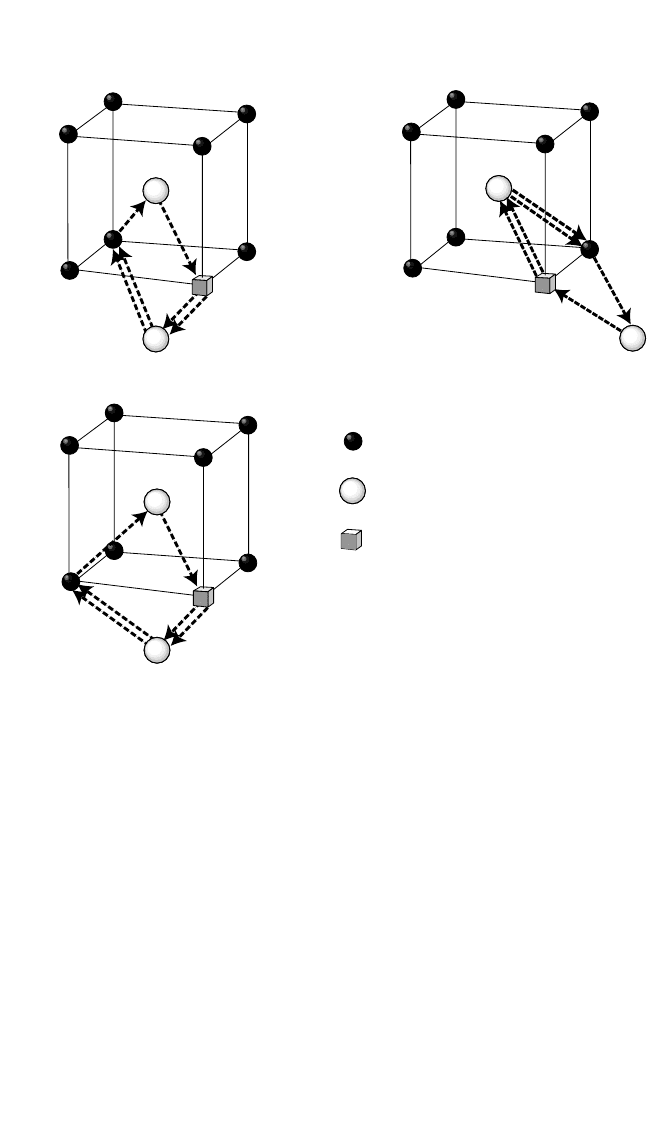Gupta D. (Ed.). Diffusion Processes in Advanced Technological Materials
Подождите немного. Документ загружается.


152 DIFFUSION PROCESSES IN ADVANCED TECHNOLOGICAL MATERIALS
transition rate Γ. Knowing all z transition rates, we selected one of them
at random, using the standard KMC procedure (Sec. 3.7.1). The clock is
advanced by the vacancy residence time (the inverse of the sum of all Γs),
and the simulation continues. Thus, the rigid-lattice assumption underly-
ing the standard KMC scheme is replaced by a relaxed lattice at each
vacancy position. More importantly, this scheme does not require a global
rate catalog that attempts to enumerate all possible environments of a
vacancy. Instead, a local catalog is constructed for each vacancy position
and used for making a decision on the next jump. However, as in regular
KMC simulations, the structure and the diffusion mechanism are postu-
lated prior to beginning the simulation.
The computational efficiency of this scheme is poor because the cal-
culation of n
0
is an extremely demanding procedure. This problem could
be alleviated by using the embedded-cluster method (Sec. 3.4.3), which
restricts the dynamical matrix calculation to a local area around the defect.
Further improvements could be achieved by combining this scheme with
the regular KMC approach. For example, the program could keep in the
memory the structures and local rate catalogs for a number of steps back.
If the vacancy returns to a previously seen configuration, the transition
rates are simply drawn from the memory, not calculated. This can help the
vacancy escape from traps more efficiently by switching to the KMC
mode. Bocquet
[107]
recently proposed a more sophisticated and presum-
ably more efficient detrapping algorithm that guarantees a quick escape of
the vacancy from a pair of sites separated by a low barrier.
A more serious problem, which does not seem to have a solution
within this scheme, is the possibility of unstable vacancy configurations.
Namely, a configuration arising after a vacancy exchange with an atom
can turn out to be mechanically unstable. In that case, the atom would
return to its initial position during the static relaxation. In terms of TST,
the barrier of the return jump is zero or negative, meaning that Vineyard’s
Eq. (42) does not apply. The occurrence of the vacancy instability signals
the existence of a cooperative vacancy jump involving a concerted dis-
placement of two or more atoms. Such unstable vacancies and coopera-
tive vacancy jumps were found in the intermetallic compound NiAl.
[101]
Unstable vacancies were also observed in the simulations of Au-Ni alloys
using this scheme.
[107]
Since the search for alternative diffusion mecha-
nisms is not a part of this scheme, the jumps leading to unstable configu-
rations had to be removed from the catalog, which we hope left the over-
all diffusion process unaffected.
[107]
Henkelman and Jónsson
[103]
proposed a more advanced OFMC
scheme, which they refer to as long-timescale KMC. From each equi-
librium position of the system, possible escape paths are explored by
performing multiple saddle-point searches using the dimer method.
[102]
Ch_03.qxd 11/29/04 6:08 PM Page 152

ATOMISTIC COMPUTER SIMULATION OF DIFFUSION, MISHIN 153
Although this procedure can never guarantee that all possible transitions
have been found, the assumption is that the most important transitions
can be identified by a reasonable number of dimer searches. The rele-
vant transition rates are calculated within the harmonic TST. All other
steps are the same as in the regular KMC. In contrast to the previous
scheme, no diffusion mechanism is imposed on the system. The system
is allowed to find the diffusion mechanisms by itself, which can be sin-
gle-atom jumps or collective events of any complexity. Moreover, the
atoms do not even have to occupy lattice positions, which makes the
method suitable for studying amorphous and other structurally disor-
dered systems. This method has been successfully applied to model
metal surface diffusion, island ripening, and surface growth.
[103]
Application to bulk diffusion in alloys and compounds would be an
interesting topic for future research.
3.8 Molecular Dynamics
3.8.1 Calculation of Diffusion Coefficients
Molecular dynamics has been a prime simulation tool in solid-state
diffusion for a few decades.
[146, 147]
In the MD method, the exact dynamic
evolution of a collection of atoms is followed by integrating the
Newtonian equations of motion. The classical forces acting on the atoms
are computed using either interatomic potentials or first-principles meth-
ods. Typically, a canonical ensemble is simulated, in which the system is
coupled to a thermostat under a temperature T. The temperature control is
implemented using the Nose-Hoover method or the Langevin equation
with random forces.
[56]
In most diffusion simulations, the system volume
is held fixed, but it can also be allowed to fluctuate to model constant-
pressure conditions. More sophisticated ensembles, such as the variable
block shape implemented in the Parrinello-Rahman method,
[148, 149]
are
also available but have rarely been applied to diffusion problems.
The most straightforward way of using MD is to calculate the diffu-
sion coefficient from mean-squared displacements of atoms. For a diffu-
sion process mediated by a single type of point defect, the procedure is
very similar to the KMC method (Sec. 3.7.1). Asingle defect is created in
the simulation block, and its random walk is implemented by making a
long MD run. The diffusion coefficient is then deduced from mean-
squared atomic displacements using Eq. (47). The equilibrium defect
concentration c appearing in Eq. (47) should be known from separate cal-
culations. [In some publications, the diffusion coefficient was deduced
directly from Eq. (46) with x 1, which is incorrect.]
Ch_03.qxd 11/29/04 6:08 PM Page 153

154 DIFFUSION PROCESSES IN ADVANCED TECHNOLOGICAL MATERIALS
An advantage of this method over KMC simulations is that diffusion
mechanisms do not have to be known in advance. The system evolves nat-
urally under interatomic forces, and the defect has all the freedom to choose
the most favorable diffusion mechanisms. Asignificant drawback, however,
is the limited computational efficiency of MD. Most of the simulation time,
atoms idly vibrate around equilibrium positions without making any contri-
bution to diffusion. Consequently, accumulating good statistics of jumping,
even at high temperatures, is highly problematic. However, estimates of dif-
fusion coefficients of both vacancies and interstitials in metals have been
obtained by this method.
[150]
For diffusion along extended defects, such as
surfaces or GBs, the jump barriers of point defects are lower than in the
bulk, and extensive diffusion can be readily observed already at medium
temperatures. But other problems that come into play are discussed next.
Consider GB diffusion as an example. Due to relatively low transition
barriers of point defects, mean-squared atomic displacements sufficient for
a reliable calculation of the diffusion coefficient can be obtained at tem-
peratures above 0.7T
m
, where T
m
is the bulk melting point.
[120, 151, 152]
With
massive parallel computations, the lower bound can be pushed down to
0.6T
m
,
[153]
and in the future, it can perhaps be pushed even lower. However,
the energy barriers for the generation of new point defects in GBs are also
relatively low, and generation events inevitably happen during the MD
simulation. The Frenkel pair formation is the most common mechanism of
defect generation, but other mechanisms can also operate, depending on
the GB structure.
[92, 93]
Under such conditions, the number of point defects
in the simulation block is no longer conserved, and the reasoning that led
us to the correction factor x in Eq. (46) no longer applies. One possible
solution could be to perform a very long MD run prior to calculating the
diffusion coefficient, with the hope that the GB would generate the equi-
librium amount of defects. Then Eq. (46) could be applied without any
prefactor. The success of this scheme would depend on the characteristic
time required for the particular GB to arrive at point defect equilibrium. It
can easily be beyond the time scale accessible by MD simulations.
Furthermore, even if the defect generation process is fast enough, the sim-
ple GB structures that are typically simulated do not contain any noncon-
servative sinks or sources of point defects. The total number of atoms in
the GB core is always conserved, meaning that the boundary can only sup-
port an equal number of vacancies and interstitials. This constraint can pre-
vent the GB from ever arriving at the true point defect equilibrium, which
in turn can affect the diffusion coefficient. Optimistically, we can hope that
some of the point defects would migrate away from the GB to the adjacent
lattice regions, bringing the GB closer to equilibrium. However, this migra-
tion also takes time, which again can be beyond the reach of regular MD
simulations. Clearly, this problem needs to be examined carefully.
Ch_03.qxd 11/29/04 6:08 PM Page 154

ATOMISTIC COMPUTER SIMULATION OF DIFFUSION, MISHIN 155
3.8.2 Diffusion Mechanisms in Grain Boundaries
Calculating diffusion coefficients is not the only way of using MD
for diffusion. MD also offers an ideal tool for the exploration of unknown
diffusion mechanisms in complex structures. As an illustration, we will
discuss the recent studies of diffusion mechanisms in GBs.
It has been the basic assumption for many years that atoms move in
GBs by simple exchanges with vacancies.
[108, 121, 154]
More recent simula-
tions of GB diffusion in Ag
[116, 152]
and Cu
[93, 114, 115, 155]
pointed to a possible
role of self-interstitials along with vacancies. In the most detailed study of
diffusion mechanisms in GBs,
[92]
diffusion in six symmetrical tilt GBs in
Cu was modeled using an accurate EAM potential
[9]
fit to both experi-
mental data and first-principles calculations. A simulation block contain-
ing about 1200 dynamic atoms was used through the work. Asingle point
defect (vacancy or interstitial) was created at an arbitrary position in the
GB core, and a long MD run was implemented at a constant temperature
of 1000 K. The computer program automatically generated a snapshot of
the block whenever a significant atomic displacement relative to the pre-
viously stored configuration pointed to a possible jump. The diffusion
mechanisms were analyzed a posteriori by examining the whole set of
snapshots produced by the MD run. All snapshots were relaxed in a static
mode, and if two consecutive snapshots were found to relax to different
states, they were assumed to be separated by a defect jump. The relevant
jump barrier and attempt frequency were then determined by the NEB
method (Sec. 3.6.2) by taking the two snapshots as the initial and final
states. These data were later fed into the KMC model for the calculation
of GB diffusion coefficients (Sec. 3.7.2). The NEB calculation also served
to verify that the two states were indeed separated by one saddle point,
which was always found to be the case. Using this laborious but robust
procedure, hundreds of defect jumps were examined and ranked accord-
ing to their rates in a chosen temperature range. The results of this analy-
sis can be summarized as follows.
Vacancies can move in GBs by single-atom exchanges, as they do in
the lattice, but they can also move by collective jumps involving a simul-
taneous displacement of several atoms. Such collective jumps always
involve GB sites that do not support a stable vacancy (Sec. 3.7.2). For
example, site 6 in the Σ 5 (310) GB [Fig. 3.8(a)] is unstable with respect
to vacancy formation: an atom removed from that site is filled by atom 1
during a static relaxation. This instability is responsible for the collective
jump 1→ 6→ 4
∼
of two atoms, as well as for the 1 → 6 → 2
∼
→ 1
∼
jump
involving three atoms. These jumps can be viewed as attempts of vacancy
1 to jump to site 6. Because the latter does not support a stable vacancy, the
vacancy is immediately filled by atom 4
∼
or 2
∼
. As a result, the vacancy jump
Ch_03.qxd 11/29/04 6:08 PM Page 155

156 DIFFUSION PROCESSES IN ADVANCED TECHNOLOGICAL MATERIALS
continues to sites 4
∼
or 2
∼
, without landing at site 6. Collective vacancy
jumps were found to be especially popular in the Σ 7(2 3
∼
1)[111] and Σ
13(3 4
∼
1)[111] GBs, in which only a few sites support a stable vacancy.
[92]
Interstitials can move by the direct or indirect mechanisms. Under the
direct mechanism, an interstitial atom is wandering along the GB by
jumping between neighboring interstitial positions. While energetically
unfavorable in Σ 5 GBs,
[93]
this mechanism was found to operate in
other GBs.
[92]
Under the indirect mechanism, an interstitial atom displaces
a neighboring regular atom to another interstitial position and takes its
1
2
2
~
1
~
6
6'
1'
4
4
~
[1 3 0]
[3 1 0]
-
[0 0 1]
1
2
I
I
~
2
~
6
~
3
~
2'
(a) Vacancy Diffusion Mechanism
(b) Interstitial Diffusion Mechanism
Figure 3.8 Vacancy and interstitial diffusion mechanisms in the Σ 5 (310)[001]
grain boundary in Cu.
[92]
Squares and circles mark atomic sites in alternating (002)
planes. Selected sites are labeled for reference. Symbol I labels interstitial posi-
tions.The prime and tilde signs mark symmetrically equivalent sites on either side
of the boundary plane or in neighboring structural units. The arrows show point
defect jumps.
Ch_03.qxd 11/29/04 6:08 PM Page 156

ATOMISTIC COMPUTER SIMULATION OF DIFFUSION, MISHIN 157
place. This process occurs by a simultaneous displacement of both atoms.
Furthermore, an interstitial atom can initiate a chain of atomic displace-
ments and push the terminal atom of the chain into an interstitial position,
which can be separated from the initial position. It is important to realize
that all atoms taking part in this process move in concert and not one after
another. Figure 3.8(b) illustrates this mechanism for diffusion perpendi-
cular to the tilt axis in the Σ 5(310)[001] GB. Notice that the same inter-
stitial jump (e.g., I → I
∼
) can be implemented in several different ways,
some of them involving more atoms than others. Interstitial dumbbells in
GBs always move by collective jumps of three or more atoms, as they do
in the lattice. The delocalized crowion-type interstitial configurations
found in the Σ 9 and Σ 11 GBs
[92, 113]
move in a highly collective way
with a very low migration barrier. At each step, individual atoms within
the displacement zone each move by a very small amount but the overall
displacement zone translates by one period along the tilt axis. This motion
looks more like a dislocation glide than an atomic jump.
Besides the vacancy and interstitial mechanisms, ring mechanisms
were also found in GBs. Aring can include up to six atoms and can either
be induced by an existing point defect or happen spontaneously without
any pre-existing defects. On the whole, diffusion in GBs is profoundly
different from lattice diffusion. It occurs by a variety of different mecha-
nisms, most of which are collective. Considering also that the collective
events often happen by a displacement of atomic chains, we can notice an
analogy with diffusion mechanisms in bulk metallic glasses.
3.8.3 Diffusion Mechanisms in Intermetallic
Compounds
Diffusion mechanisms in ordered intermetallic compounds have
been an attractive subject for modeling and simulation for a few
decades.
[34, 106, 156]
(See Chapter 4.) It is generally recognized that diffusion
in such compounds is mediated by vacancies, but the question is, how
exactly do the vacancies move in a structure with long-range order? Aran-
dom vacancy walk would inevitably involve inter-sublattice jumps, which
would soon produce a large amount of antisite defects and eventually
cause a complete disorder of the compound. Vacancies should, therefore,
move in a highly correlated way to preserve the equilibrium degree of
long-range order. Identifying such correlated mechanisms is the key issue
in this area. The simplest possible mechanism is one in which vacancies
migrate on their own sublattices without any inter-sublattice jumps. This
mechanism obviously preserves the crystal order. Alternatively, a number
of cyclic mechanisms have been proposed in which the order is
Ch_03.qxd 11/29/04 6:08 PM Page 157

158 DIFFUSION PROCESSES IN ADVANCED TECHNOLOGICAL MATERIALS
destroyed only locally and temporarily and is fully recovered once the
cycle is complete. All mechanisms that have been proposed so far are
based on geometric considerations and have been studied primarily by
KMC simulations within simple models (Sec. 3.7.3). Instead of attempting
to review this whole area, we will focus on recent evaluations of diffusion
mechanisms in the B2-NiAl compound by means of atomistic calculations.
Our aim is to demonstrate the capabilities of atomistic simulations rather
than to make final judgments regarding the role of particular mechanisms.
Similar atomistic calculations of diffusion mechanisms have been performed
for B2-FeAl
[157]
and Ti aluminides TiAl and Ti
3
Al.
[80]
NiAl is a triple defect compound in which the off-stoichiometry on
the Ni-deficient side is accommodated by structural vacancies on the Ni
sublattice, whereas Ni-rich compositions are dominated by Ni
Al
antisites
[Fig. 3.3(b)]. Given this asymmetry of the disorder mechanism, we should
anticipate an asymmetry and multiplicity of diffusion mechanisms in this
compound. An important feature of the B2 structure is that Ni atoms are
surrounded by Al atoms only and vice versa. Thus, this structure does not
support sublattice diffusion by nearest neighbor jumps. Several diffusion
mechanisms have been proposed for NiAl, including sublattice diffusion
by next-nearest neighbor (NNN) vacancy jumps on the Ni sublattice,
[94, 158]
six-jump vacancy cycles (6JCs),
[97, 159, 160]
the anti-structural bridge (ASB)
mechanism,
[161]
and the triple defect mechanism.
[96, 162]
Some of the mech-
anisms were examined by atomistic computer simulations, with contro-
versial results. For Ni diffusion in NiAl, the lowest activation energy
(2.76 eV in the stoichiometric composition) was found for the NNN
vacancy mechanism, with slightly higher activation energies for the ASB
and 6JC mechanisms.
[94, 163]
It is tempting to conclude that Ni diffuses in
NiAl predominantly by NNN jumps along its own sublattice. However, if
the NNN vacancy mechanism were indeed dominant, this would lead to a
very high Ni diffusivity in Al-rich compositions containing a large amount
of Ni vacancies. This is contrary to the experimental observations by
Frank et al.,
[96]
who found the Ni diffusivity to be about the same in the
stoichiometric and Al-rich compositions. Frank et al. suggested that the
NNN vacancy mechanism is not the dominant one, at least not in the tem-
perature range of their measurements. Instead, they proposed a triple defect
mechanism. The estimated activation energy of the triple defect mecha-
nism (3.18 eV, regardless of the composition) compares reasonably well
with the experimental activation energy in Al-rich and near-stoichiometric
compositions (3.00 ± 0.07 eV), but fails to explain the drop in the exper-
imental activation energy in Ni-rich compositions (53 at.% Ni). Frank
et al. have attributed this drop to a contribution of the ASB mechanism
arising when the concentration of antisites on the Ni sublattice reaches the
percolation threshold.
Ch_03.qxd 11/29/04 6:08 PM Page 158

ATOMISTIC COMPUTER SIMULATION OF DIFFUSION, MISHIN 159
Some of these mechanisms have recently been revisited with more
advanced simulation techniques.
[101, 164]
Using an accurate EAM potential,
the migration energy of the NNN jump of a Ni vacancy was found to be
e
m
2.33 eV, a value consistent with concurrent first-principles calcula-
tions.
[101]
This value is low enough to make NNN jumps a plausible diffu-
sion mechanism in NiAl. Since this mechanism presents a standard case
of diffusion on a simple cubic lattice (i.e., Ni sublattice), the activation
energy and pre-exponential factor of diffusion can be readily found, pro-
vided we know the effective formation energy and entropy of Ni vacan-
cies. For the stoichiometric composition, these are given by e
TA
3 and
s
TA
3, respectively, where e
TA
and s
TA
are the energy and entropy of the
triple defect on the Ni sublattice (Sec. 3.5.2). The values of e
TA
and s
TA
cal-
culated with the same EAM potential are listed in Table 3.1. The resulting
expressions for the Arrhenius parameters are:
D
0
2
13
a
2
f
0
n
0
exp
, (49)
Q e
m
. (50)
Here, a is the lattice parameter of NiAl, f
0
0.653 is the geometric cor-
relation factor for the simple cubic lattice, and n
0
is the attempt frequency
that was also calculated by Mishin et al.
[101]
Calculations from these equa-
tions give Q 3.09 eV and D
0
1.6 10
6
m
2
/s, which compare rea-
sonably well with the experimental values Q 3.0 eV and D
0
3 10
5
m
2
/s.
[96]
This agreement suggests that NNN vacancy jumps in NiAl are
capable of contributing to Ni diffusion significantly and cannot be totally
excluded from the possible mechanisms.
Using static calculation, the 6JC mechanism in NiAl was also eval-
uated.
[101]
Geometrically, the B2 structure is able to support a [110] cycle
as well as straight and bent [100] cycles (Fig. 3.9). As a result of a cycle,
the Ni vacancy makes a [100] or [110] jump and simultaneously
switches positions of two Al atoms. Each cycle starts with an exchange
of the Ni vacancy with a neighboring Al atom. Calculations have shown
that, contrary to the commonly accepted picture of the 6JC mechanism,
the configuration arising after this first jump is mechanically unstable.
Because of this instability, the vacancy exchanged with an Al atom
returns to its initial position during static relaxation. This important fact
was verified by independent first-principles calculations.
[101]
As we
mentioned before, mechanical instability of a vacancy is always a sign
e
TA
3
s
TA
3k
B
Ch_03.qxd 11/29/04 6:08 PM Page 159

160 DIFFUSION PROCESSES IN ADVANCED TECHNOLOGICAL MATERIALS
of a collective jump. Indeed, it was found by NEB calculations that the
first jump of a cycle merges with the second one and forms a collective,
two-jump transition.
Three types of such collective jumps are geometrically possible in the
B2 structure, as shown schematically in Fig. 3.6. Jumps 1-2 and 1-2 ini-
tiate [110] and [100] 6JCs, respectively, while jump 1-2 is not involved
in the 6JC mechanism and simply creates two antisites. Due to the inher-
ent symmetry of 6JCs, we can conclude that their last two jumps should
also merge and form collective transitions. Furthermore, NEB calcula-
tions have shown that the central configuration of the [110] cycle is also
mechanically unstable, so that the whole cycle happens as three collective
transitions. For the [100] cycles, the central configuration is stable, and
the cycles happen by two collective transitions separated by two single-
atom jumps. Thus, contrary to the existing paradigm, 6JCs in NiAl happen
1
2
Ni
Al
Vacancy
3
4
5
6
1
2
3
4
5
6
1
2
3
4
5
6
(a) [110]
Cycle
(b) [100] Straight
Cycle
(c) [100]
Bent Cycle
Figure 3.9 Schematic illustration of six-jump vacancy cycles in the B2 structure of
NiAl.The arrows show vacancy jumps; the numbers label the jump sequence.
Ch_03.qxd 11/29/04 6:08 PM Page 160

ATOMISTIC COMPUTER SIMULATION OF DIFFUSION, MISHIN 161
by either three or four vacancy jumps, not six. This conclusion may have
an impact on future calculations of correlation effects associated with this
mechanism. The collective transitions may also need to be incorporated
into future KMC simulations. NEB calculations also revealed that the
[110] cycle is energetically substantially more favorable than [100]
cycles, suggesting that it is the [110] cycle that should be studied more
carefully in the future.
Diffusion mechanisms in stoichiometric NiAl were also studied by
MD.
[164]
Since the same EAM potential was used, the results could be
directly compared with the static calculations of Mishin et al.
[101]
MD sim-
ulations of NiAl present a serious computational challenge. Due to the
high migration barrier of vacancy jumps (~2.5 eV), the vacancy residence
time is on the order of a nanosecond or longer, even near the melting
point. Consequently, producing even a few hundred vacancy jumps in a
sizable simulation block is already a formidable task for today’s comput-
ers. The simulations were performed at 1900 K (slightly below the exper-
imental melting point) on a 1024-atom simulation block containing a
single vacancy. The vacancy was initially created on a Ni site and was
observed to remain on the Ni sublattice through most of the simulation
time. This observation is consistent with the predominance of Ni vacan-
cies over Al vacancies in this compound [compare Fig. 3.3(b)]. Asnapshot
was saved each time the atomic displacements exceeded a preset critical
value that could signal vacancy jumps. By analyzing the whole set of stat-
ically relaxed snapshots after the MD run, a few hundred sequential
vacancy jumps were found, and their barriers were determined by NEB
calculations. The following diffusion mechanisms were deduced from this
analysis: (1) NNN vacancy jumps on the Ni sublattice; (2) [110] 6JCs
implemented by three collective transitions; and (3) collective [111]
jumps (1-2 in Fig. 3.6). The latter jumps created short-lived configura-
tions that were annihilated by a reverse jump after less than a picosecond.
Such distracting jumps often occurred during the 6JCs but did not change
their course. They also happened very often between NNN jumps or 6JCs.
Collective 1-2 jumps were observed several times but were soon
reversed, and none of them resulted in a complete [100]-type 6JC.
These simulations present what appears to be the first direct observa-
tion of the NNN and 6JC diffusion mechanism in NiAl by MD, along with
a proof of the collective nature of many diffusive events in this compound.
It would be premature to conclude that these two mechanisms totally
dominate diffusion in NiAl. This work did not address other geometrically
possible mechanisms whose simulation would require more than a single
vacancy. For example, to study the triple defect mechanism, two vacan-
cies and an antisite would need to be created in the simulation block.
Although the question of the dominant diffusion mechanism in NiAl
Ch_03.qxd 11/29/04 6:08 PM Page 161
